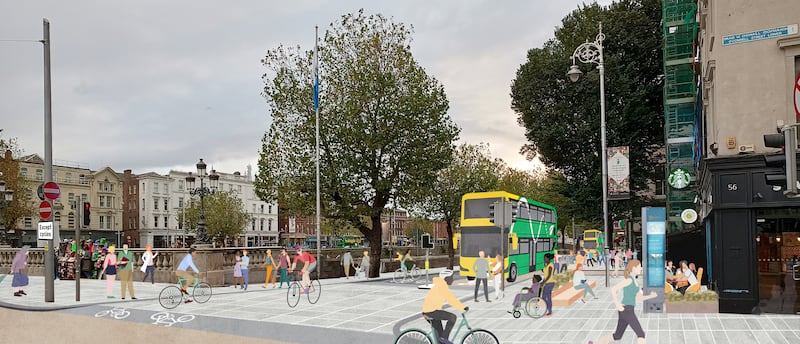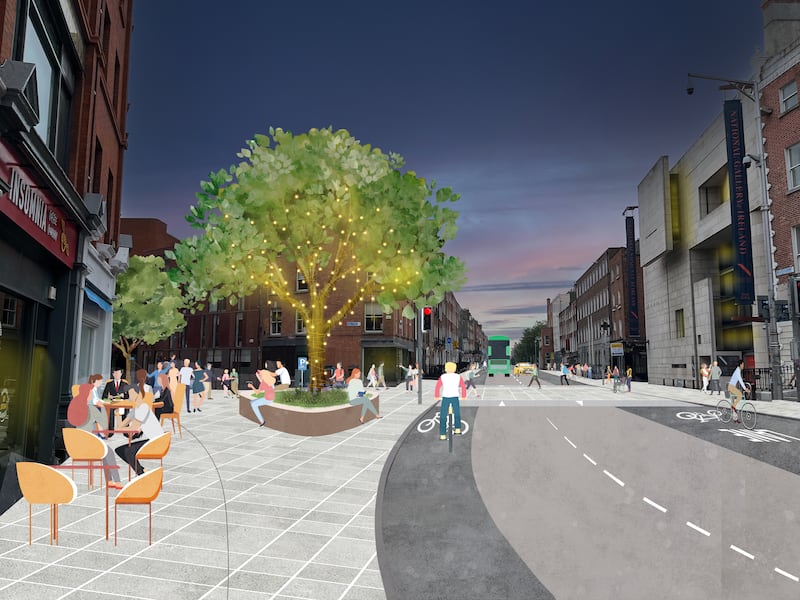Bans on private cars and commercial vehicles travelling through Dublin city centre will be in place by August, Minister for Transport Eamon Ryan has said.
The Dublin City Centre Transport Plan, which was presented to city councillors on Wednesday afternoon, aims to stop motorists from driving “through” instead of “to” Dublin city.
Two out of every three cars currently using the city streets do not have the centre as their destination according to Dublin City Council.
The plan will aim to block these motorists by limiting parts of the north and south quays to public transport only and by introducing a series of civic plazas and restrictions on where traffic can turn. It does not prevent motorists from accessing the city centre, with routes to businesses and car parks retained, but it aims to end the dominance of cars on the city’s streets.
Pamela Anderson: ‘I felt like life was really like death for me’
Dr Lydia Foy: ‘I never got an apology actually. It would be nice to get one’
From journalist to lecturer to Buddhist priest: ‘Everyone is obsessed with their own self’
Pantera live in Dublin review: Growling vocals, crowd surfing and mosh pits. This gig was worth the wait
Councillors welcomed the final plan, presented to the city council traffic and transport committee along with a report on public submissions which showed more than 80 per cent support for the measures.
“Dubliners are now saying its time to call a halt to the inexorable march of the motor car,” Fine Gael councillor Paddy McCartan said. “We are all familiar with rat runs in housing estates, but in effect what people are doing is using our city streets as a vast rat run to go through the city when they have definite other alternatives.”
Green Party councillor Michael Pidgeon said the message needed to go out that people were welcome in town by any means, including cars, but the days of using the city centre as a through route were over. “I am 35 and in those 35 years I can’t think of a time the quays have worked traffic-wise, they have always been snarled up with traffic...It is time to say enough and to treat the city centre with respect.”
His party colleague Janet Horner said: “This is a big opportunity for the city to take a leap forward get serious about the traffic that has ensnared the city.”
Sinn Féin councillor Larry O’Toole said he looked forward to safer cycling and more efficient bus services the plan would achieve. “This will be prove to be a very ambitious but brave development in the city.”
Indepdendent councillor Mannix Flynn said there was a “definite need for change in the city centre” but he was concerned there might be a legal challenge to the plan. “My hope is there wouldn’t be a legal challenge when this is initiated but I am beginning to think that will be the case, that there will be legal challenge to it, and that would be unfortunate.”
The meeting heard from Richard Guiney, chief executive of business organisation DublinTown, who said the reaction from the business community was “overall positive”.
“In terms of making it work, we have ideas around shared deliveries and the activation of space in the city that becomes pedestrianised so we don’t have antisocial behaviour,” he said. “I think ultimately there are a lot of brains in the city and if we could deploy all of those brains we can overcome the challenges that could emanate from the plan.”
Speaking at an event on Wednesday to publicise the allocation of €290 million in funding for walking and cycling across the State, Mr Ryan said the Dublin traffic plan would have a “transformative” effect on the city centre from later this year.
“People will see a transformation this August when we take the through traffic out of the city centre. That is going to make a huge change in Dublin,” he said. “We will see a tipping point where we will see a large increase in cycling and walking as a mainstream form of transport for our city.”
The €290 million “active travel” fund includes €500,000 for the development of a traffic free plaza at Dublin’s College Green, which Mr Ryan said was long overdue.
“It’s ridiculous it’s taken so long, stuck in planning the ways it has,” he said. “Look at what’s happening in comparative cities. Look at what they’ve done in Paris, look at what they are doing in London. We need to do the same, starting with College Green.”
Under the city centre transport plan, the new civic plaza is due to be developed from next year.

Two new “bus gates” are to be introduced on the quays close to O’Connell Bridge this year, one on the north side at Bachelors Walk stopping cars and lorries from heading east towards the Custom House and the docklands. The other would be on Aston Quay on the southside, stopping private traffic from travelling from O’Connell Bridge in the direction of Heuston Station.
Private traffic would also be stopped turning left from Westland Row onto Pearse Street, with vehicles instead having to turn right and move away from the city. This would require a new two-way traffic section from Westland Row to Sandwith Street.
This change should result in significantly less traffic on Pearse Street heading towards Tara Street, allowing a reduction in traffic lanes and the introduction of two-way cycle lanes.
The plan will also make Parliament Street traffic-free and proposes new civic plazas at the Custom House and at Lincoln Place near the back entrance to Trinity College.

The Statewide Active Travel Investment Programme for 2024 will fund around 800 new and existing projects. Among the largest to receive funding in this year are the Fairview to Amiens Street Cycle Route in Dublin, the Marina Promenade Pedestrian and Cycle Facilities in Cork, the Father Russell Road Cycle Scheme in Limerick, the Waterford Sustainable Transport Bridge, the Ballaghaderreen Town Development in Co Roscommon, and the One-Way Active Travel scheme in Donegal Town.
- Sign up for push alerts and have the best news, analysis and comment delivered directly to your phone
- Find The Irish Times on WhatsApp and stay up to date
- Our In The News podcast is now published daily – Find the latest episode here











